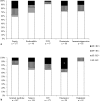SeptiFast versus blood culture in clinical routine - A report on 3 years experience
- PMID: 28243751
- PMCID: PMC5486735
- DOI: 10.1007/s00508-017-1181-3
SeptiFast versus blood culture in clinical routine - A report on 3 years experience
Abstract
Background: In recent years a multiplex real-time PCR (SeptiFast) has been introduced, allowing detection of 25 common blood pathogens considerably faster than conventional blood culture.
Methods: SeptiFast was applied routinely in addition to blood culture in cases of critically ill patients with fever and other signs of severe systemic infections. In this study data of 470 episodes were retrospectively analysed to assess the impact of various parameters, such as clinical indications, assigning ward and antimicrobial treatment on test outcome using a multivariate logistic model.
Results: After exclusion of microorganisms classified as contaminants, the concordance between SeptiFast and blood culture was 85.5%. SeptiFast detected 98 out of 120, while blood culture merely found 63 out of 120 potential pathogens. In comparison to blood culture, SeptiFast showed considerably higher positivity rates in sepsis, pneumonia and febrile immunosuppression and a lower rate in endocarditis. The highest positivity and concordance between tests was shown in patients from the emergency room (P = 0.007).
Conclusions: The results obtained in this study are similar to those from prospective settings confirming the robustness of the SeptiFast assay in routine use. Our data suggest that SeptiFast is a valuable add-on to blood culture and may increase the diagnostic efficiency of a microbiological laboratory.
Keywords: Blood culture; Diagnostics; Routine use; Sepsis; SeptiFast.
Conflict of interest statement
The authors have no financial relationship with the organization that sponsored the research. The sponsor had no role in the study design, in the collection, analysis and interpretation of data, the writing of the report and the decision to submit the article for publication. F. Korber, I. Zeller, M. Grünstäudl, B. Willinger, P. Apfalter, A.M. Hirschl and A. Makristathis declare that they have no competing interests.
Figures

References
Publication types
MeSH terms
LinkOut - more resources
Full Text Sources
Other Literature Sources
Medical

